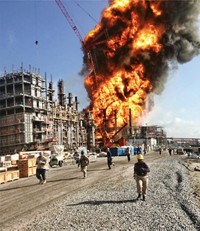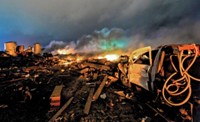Advertisement
Grab your lab coat. Let's get started
Welcome!
Welcome!
Create an account below to get 6 C&EN articles per month, receive newsletters and more - all free.
It seems this is your first time logging in online. Please enter the following information to continue.
As an ACS member you automatically get access to this site. All we need is few more details to create your reading experience.
Not you? Sign in with a different account.
Not you? Sign in with a different account.
ERROR 1
ERROR 1
ERROR 2
ERROR 2
ERROR 2
ERROR 2
ERROR 2
Password and Confirm password must match.
If you have an ACS member number, please enter it here so we can link this account to your membership. (optional)
ERROR 2
ACS values your privacy. By submitting your information, you are gaining access to C&EN and subscribing to our weekly newsletter. We use the information you provide to make your reading experience better, and we will never sell your data to third party members.
Safety
Overhauling Plant Safety Rules
Federal working group cites need for reforms, but agencies seek more review
by Glenn Hess , Jeff Johnson
September 22, 2014
| A version of this story appeared in
Volume 92, Issue 38

At the direction of President Barack Obama, his Administration is considering a broad array of reforms to chemical plant safety and security policies. But any new regulatory action is likely to be years away.
After nearly a year of study, an interagency working group delivered a report to the White House this summer that identifies the need for a safety and security regulatory overhaul. Rather than action, though, the report calls for more input. And each of the three agencies that led the review has sought additional public comment.
The slow pace dismays community activist groups, unions, and others. They hoped Obama’s directive would encourage the federal government to require industries to adopt safer technologies and modernize 20-plus-year-old regulatory programs that govern production and storage of hazardous chemicals. These regulations don’t include most reactive substances, such as ammonium nitrate, the chemical that exploded in April 2013 at a farm supply facility in West, Texas, killing 15 people and injuring hundreds more.
“We have to get beyond the false hope that industry will voluntarily protect us. We need federal requirements for facilities to convert to safer chemicals and technologies,” says Juan Parras, director of Texas Environmental Justice Advocacy Services, in Houston. “Our communities have already waited too long, through disaster after disaster.”
In the wake of the blast in West and other recent accidents, Obama ordered six federal agencies to form a working group to review existing plant and worker safety laws and industry practices. The President directed them to consider new ways to reduce the threat of chemical disasters. He put the Environmental Protection Agency, the Department of Homeland Security, and the Occupational Safety & Health Administration in charge of the effort. The Departments of Agriculture, Justice, and Transportation also participated.
The President signed the executive order Aug. 1, 2013, and set a tight schedule calling for a detailed report within 270 days. The interagency group heard from 1,800 stakeholders at “listening sessions,” webinars, and public dockets.
Although Obama issued his directive with fanfare, the working group’s report was quietly released on a Friday in June. It calls for more review before any new action is taken, avoiding new mandates on chemical facilities.
The report could, however, open the door to regulatory modifications in the future, but possibly not until after Obama leaves office. Although the report describes an intent to finalize changes in 2016, these could be subject to “timing adjustments that may be necessitated by new information.”
Community organizations and unions representing chemical workers and firefighters are disappointed that the Administration is moving without urgency. The International Association of Fire Fighters says that if safety regulations controlling the storage and handling of ammonium nitrate had been in place, the incident at the West facility would have been minimized and the lives of 12 emergency responders saved.
“There are recommendations in their report that can help prevent disasters if they are enacted. But words are not enough,” says Richard Moore, co-coordinator of the Louisville, Ky.-based Environmental Justice & Health Alliance for Chemical Policy Reform. “The Administration has to turn these words into actions—into regulations.”

Obama’s order pointed to several areas for the interagency working group to examine, including inherently safer technology (IST). Several labor and environmental organizations urged EPA to quickly use its authority under the Clean Air Act to order facilities to adopt IST methods. These include switching to less toxic chemicals or making process changes to reduce the consequences of an accidental chemical release or a terrorist attack.
The report notes there is widespread support for IST from both labor and community groups as well as industry, according to EPA officials. The agency is considering what role—if any—the federal government should play in encouraging application of IST principles, says Nitin Natarajan, EPA’s deputy assistant administrator for solid waste and emergency response.
“The question we’re looking at is not necessarily, ‘Is IST good or bad?’ because we’ve heard from industry that IST is a good thing,” Natarajan says. “We’re not getting into a debate about what practices are good or bad or indifferent. The question is: What is the federal government’s role in IST within our existing programs?”
Chemical companies have long opposed any federal mandate for IST consideration or implementation. They argue that they already have strong incentives to maintain safe facilities and that plant managers are best equipped to make process safety improvements (C&EN, March 10, page 11).
Administration officials appear to share that view. EPA will not require chemical facility operators to adopt any particular technology or process, even if the agency moves forward with regulations, Natarajan says. The agency does not want its employees “sitting in D.C. making decisions on what a facility should do. That is not the role that we want to play.”
Although it is rejecting prescriptive application of IST, the federal working group says the Administration will seek to address safety concerns by modernizing and improving existing regulatory programs. Highlighted in the report are three regulatory areas of particular concern to industry, safety experts, and community organizations: OSHA’s Process Safety Management of Highly Hazardous Chemicals (PSM) standard, EPA’s Risk Management Plan (RMP) program, and DHS’s Chemical Facility Anti-Terrorism Standards (CFATS) program.
But the agencies are not yet prepared to make changes. They have all issued requests for further information, possibly adding years to the time it will take to put any eventual new regulation in place.
However, the working group acknowledged the need for modernization. It noted that both the PSM standard and the RMP requirement have not been updated since Congress created them in 1990 through amendments to the Clean Air Act.
PSM is an analytical tool that requires close examination of manufacturing processes that use chemicals specifically identified in the regulation. The standard sets requirements aimed at preventing and mitigating catastrophic releases of flammable, explosive, reactive, and toxic chemicals that may endanger workers.
A key provision requires a process hazard analysis based on a compilation of process safety information. The analysis is a careful review of what could go wrong and what safeguards must be implemented to prevent releases of hazardous chemicals in the workplace.
In their report, the working group says the current PSM standard is an obstacle to effective OSHA enforcement and is delaying introduction of better management practices that control hazards and protect workers.
Although the report lauds the past success of the provision, it identifies 27 chemical-related industrial incidents that occurred over the past five years, resulting in more than 75 deaths, multiple injuries, and significant consequences for workplaces and communities. This list covers a wide range of U.S. facilities and includes food processors, on- and offshore drilling sites, refineries, and chemical plants.
OSHA issued its request for information in December 2013. It asked for feedback about the possibility of removing an exemption in PSM regulations for atmospheric storage tanks, including at oil and gas drilling operations, and expanding PSM coverage to include reactive chemicals as well as ammonium nitrate.
The Labor Department agency received 103 comments, two-thirds of which were from industry associations and individual companies. They do not want the regulation changed.
The American Petroleum Institute, the oil industry’s main trade group, opposes expansion of PSM to drilling operations and storage tanks. It urges OSHA to seek further information before proposing regulations. The American Chemistry Council, a chemical industry trade association, also asks for more time before OSHA proposes a regulation, saying that its member companies have recently instituted a new suite of internal safety programs. ACC says it sees no reason to fix a PSM program that is “not broken.”
On the other hand, OSHA’s call for more information was criticized by chemical worker unions, the Chemical Safety & Hazard Investigation Board, and a mix of safety groups. They say the need for a PSM overhaul has been debated for more than a decade. They point to letters unions sent to OSHA in 2003 urging the agency to modernize the regulation and expand it to include all reactive chemicals. They also single out a 2002 study by the safety board that identified 167 serious incidents in the U.S. involving uncontrolled chemical reactions from January 1980 to June 2001. Those accidents killed 108 workers.
Lisa Long, director of OSHA’s Office of Engineering Safety, stresses that these comments are under review. If the agency determines changes are necessary, she adds, the process of creating a new regulation could take years to complete.
Another goal set in the working group’s report is to modernize the RMP program, which imposes requirements on owners of facilities that store, produce, or use large quantities of specified hazardous chemicals. They must report the potential effects of a chemical release, explain their efforts to prevent accidents, and provide accident emergency response plan details.
Federal Attention To Chemical Plant Security
An interagency working group focused on reshaping current federal programs and plans to improve the safety and security of chemical facilities. The recommended steps include:
◾ Clarify confusing and misunderstood policies, such as revising the current interpretation of chemical concentrations covered by OSHA’s Process Safety Management (PSM) standard to more clearly describe what is covered.
◾ Update the PSM standard to incorporate lessons learned from enforcement and accident investigation, as well as advances in industry practices, root-cause analysis, process safety metrics, employee involvement, third-party audits, and emergency response practices.
◾ Expand coverage and requirements for reactive chemicals, which have caused many accidents.
◾ Modernize EPA’s Risk Management Plan program by considering the addition of new provisions on prevention and emergency response.
◾ Strengthen DHS’s Chemical Facility Anti-Terrorism Standards (CFATS) program by revising the federal list of more than 300 “chemicals of interest” and improving the methodology used to identify chemical facilities and categorize them by risk.
◾ Work with Congress on long-term CFATS authorization to prevent lapses in the program and provide regulated chemical facilities with the certainty they need as they consider making substantial capital investments in security measures.
In EPA’s request for more information, issued in July, the agency said it is considering whether to add ammonium nitrate and other reactive and explosive chemicals to the list of 77 toxic and 63 flammable substances already covered by its regulation. In addition, the agency is considering whether to change the threshold that leads to coverage under the RMP program.
Officials are also looking at potentially requiring facilities to assess whether new, alternative processes could reduce risk. They are weighing whether to mandate buffer zones around facilities housing dangerous substances and strengthen maintenance requirements.
Although the report does not directly address inspections, it notes that EPA has the resources to annually inspect only 450 of the more than 12,000 facilities covered by the RMP provisions. In response to the executive order, the working group initiated a pilot study of a related safety program that requires companies to report hazardous chemical inventories. The information is intended to inform emergency responders of the dangers that may await them when responding to an accident. The pilot program, which was tested in New York and New Jersey, found that only 13 of 30 facilities in those states had made accurate chemical inventories publicly available.
EPA’s comment period closes in late October, after which the agency will assess feedback it received.
In mid-August, DHS requested information on possible changes to its seven-year-old chemical plant security program. The department is considering a broad set of reforms, including whether to expand the CFATS program to cover additional chemicals or change the threshold quantities it uses to help determine whether facilities are high risk.
Caitlin Durkovich, DHS assistant secretary for infrastructure protection, says the department particularly wants to hear about possible modifications to the list of chemicals, especially substances that if stolen or diverted could endanger human life.
IST figures prominently in discussions of CFATS, and David Wulf, director of infrastructure compliance for DHS, is another Administration official who has cast doubt on whether a regulatory mandate is necessary. Companies can avoid having to comply with the costly requirements of the CFATS program by voluntarily switching to safer processes or by reducing their inventory of any one of the more than 300 “chemicals of interest” listed in the regulation.
“CFATS is really very naturally, organically promoting the consideration and adoption of safer technologies, inherently safer processes,” Wulf says. He notes that more than 3,000 facilities have reduced or eliminated their on-site storage of hazardous chemicals so that they are no longer subject to DHS oversight as a high-risk facility.
In delivering their recommendations to the White House, the working group chairs pointed out that lax safety conditions had led to the executive order. They cited “recent catastrophic chemical facility incidents in the U.S.” and a need to “enhance the safety and security of chemical facilities and reduce risks associated with hazardous chemicals.” However, they underscored that the report was a “milestone, not an end point.”
Moving to that end point is likely to fuel a tense debate and take years to resolve.





Join the conversation
Contact the reporter
Submit a Letter to the Editor for publication
Engage with us on Twitter